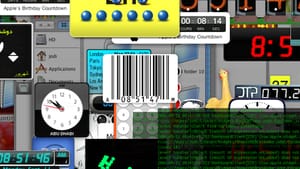Stay in the Loop
BSR publishes on a weekly schedule, with an email newsletter every Wednesday and Thursday morning. There’s no paywall, and subscribing is always free.
Digital killed the video star
Institute of Contemporary Art presents 'Broadcasting: EAI at ICA'

Have you changed the media you take in, or has it changed you? The Institute of Contemporary Art’s Broadcasting: EAI at ICA pairs with New York’s Electronic Arts Intermix, founded in 1971 to develop and advocate for video as an art form. Together, they showcase the work of 16 prominent artists associated with this movement.
Our culture has been shaped by narrative cinema, so it takes some adjustment to appreciate the merits of video art. Lacking cinematic conventions, video challenges our understanding of visual communication.
"Strange" setup
The success of this exhibit hinges on the viewer’s understanding of both broadcast video and digital media as temporary media whose history is still being written. With the current rate of technological advancement, all of our contemporary formats (BluRay, DVD, even streaming video codecs) are likely to be outmoded within decades, if not sooner.
I found the exhibit’s placement a little strange; it is only accessible by walking through Cary Leibowitz’s show on the gallery’s second floor. My first impression was the stark contrast between the playful, colorful pop art in the larger gallery and this underwhelming layout, containing a half-dozen TV sets and screens in an otherwise empty room. A few haphazardly placed folding chairs evoke the atmosphere of a TV station's control room.
At first I couldn’t discern a cohesive theme, and there was no clear order in which to view the monitors. The setup is additionally restrictive in that you cannot select which videos you want to watch. Instead, you wait as they cycle through a preprogrammed 35 minutes. Sure, the lack of choice in programming echoes the broadcast television format. But in this age of streaming video content, one has to wonder how many people under the age of 30 will appreciate this limitation. Will they be willing to give the exhibit the time required to view a full content cycle?
Context needed
The first piece I engaged with was Ulysses Jenkins’s Bay Windows, an 84-minute documentation of a 1991 performance-art event. The piece is continuously projected in a loop on the gallery’s largest screen. The video is composed of pixelated photographs and video stills punctuated by slowly scrolling lines of interference.

Washed-out and monochromatic images of children and other figures stare out vacantly, providing an ominous backdrop that haunts the exhibit. Perhaps indicative of my own predilection for narrative cinema, I couldn’t help but think of the 2001 Japanese horror film Pulse, whose premise is that digital technology is inherently evil.
Kristin Lucas’s Cable Xcess is one of the collection’s more traditional pieces. Lucas’s video shows a talking-head shot of a woman explaining the physical and mental risks of overindulging in cable television. A medley of television programs is superimposed on the background. Its message is a bit on the nose, but I found it helpful in understanding some of the exhibit’s underlying themes.
While the show’s catalogue includes descriptions of the artists and their works, it does not provide adequate historical context for what distinguishes these pieces as art. Most of the works lack even the technical skills of student filmmakers. One could argue they only gain deeper significance because they’re included in this exhibit.
What's your OS?
However, I found the pairing of Jenkins’s Inconsequential Doggereal and JODI’s My Desktop to be an excellent juxtaposition between the respective horrors of video and digital formats. In both cases, the automated nature of these media results in something grotesque or inhuman.
Jenkins’s work reverberates with the constant noise of cable television in an endless cycle of consumerism. The artist appears to be questioning his place in the world while navigating a stream of audiovisual stimuli that seeks to both define him and challenge the nature of his existence.
By comparison, My Desktop uses the familiar image of a Mac OSX desktop computer being inundated with too many operations at once: create new file, copy file, open file. The result is complete visual overload. The computer struggles to keep up with the demands, while the user is equally unable to make sense of the myriad distractions.
Both pieces immerse the viewer/user in stimuli that create a sort of symbiosis between the self and the visual medium.
This exhibit makes us question the role of technology in our lives and the way electronic modes of communication increasingly define the human experience. Given our difficulty in comprehending a future beyond our own lifespan, the sense of impermanence invoked by many of these pieces is uncomfortable. But perhaps it’s also necessary.
What, When, Where
EAI at ICA. Through March 25, 2018, at the Institute of Contemporary Art, 118 S. 36th Street, Philadelphia. (215) 898-7108 or icaphila.org.
Sign up for our newsletter
All of the week's new articles, all in one place. Sign up for the free weekly BSR newsletters, and don't miss a conversation.

 Rob Buscher
Rob Buscher